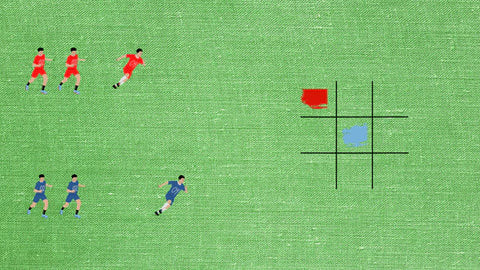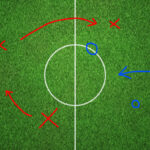Are you looking for Fun Football Games For Kids to make training sessions more engaging and effective? Discover the best football games for kids that enhance dribbling, passing, and teamwork. CAUHOI2025.UK.COM offers comprehensive guides and resources to help young players develop a love for the sport while improving their skills.
Table of Contents
- Sharks and Minnows
- Piggy in the Middle
- Musical Balls
- Cops and Robbers
- Trick or Treat
- Four Goals
- Simon Says
- Tic-Tac-Toe
- Frequently Asked Questions (FAQs)
1. Sharks and Minnows
Sharks and Minnows is an excellent game for kids to enhance their dribbling skills and ball protection. The game involves one player as the “shark” trying to take the ball from the other players, the “minnows,” as they dribble from one end of the field to the other.
To set up Sharks and Minnows, ensure the playing area is approximately 20 by 25 yards or 25 by 30 yards. The shark starts in the middle without a ball, while the minnows each have a ball at one end. The minnows must dribble to the opposite end without the shark kicking their ball out of bounds. If a minnow’s ball is kicked out, they become a shark. The game continues until only one minnow remains, who is declared the winner.
2. Piggy in the Middle
Piggy in the Middle is a classic and simple game perfect for warming up and improving passing skills, especially for younger players around 5 years old.
To play Piggy in the Middle, players form a circle with one or two players in the middle acting as “piggies.” The players in the circle pass the ball around, trying to keep it away from the piggies, who attempt to intercept it. When a piggy intercepts the ball, they switch places with the player who lost the ball. This game focuses on accurate and quick passing.
3. Musical Balls
Musical Balls is a fun and engaging game that serves as a great warm-up drill, improving ball control and quick movement for at least four players.
Each player dribbles their ball within the designated playing area. After about 30 seconds, a signal is given (e.g., the coach yells “change”). Players must stop dribbling, leave their ball, and find a new ball to dribble. In each round, one ball is removed, and the player without a ball is out. The game continues until only one player remains with a ball, making them the winner.
4. Cops and Robbers
Cops and Robbers is an exciting game played in a central playing area with a designated “bank” (a small square or triangle made with cones). This game involves assigning players as “cops” or “robbers,” with twice as many cops as robbers.
The robbers start inside the bank without a ball, and the cops start around the edges with a ball each. The robbers must take balls from the cops and dribble them to the bank, ensuring the ball stops completely inside. If a ball rolls out, the cop is still in the game until it stops. When a robber successfully banks a ball, the cop who lost the ball becomes a robber. The last cop remaining wins.
5. Trick or Treat
Trick or Treat is an excellent game for practicing quick dribbling, requiring at least four players and a ball for each. The playing area is a 15 by 15 square, marked with cones, and extra cones are placed on each end line as “treats.”
Players line up at one end line, and the coach yells, “Trick or Treat!”. Players dribble to the opposite end, collect one cone at a time, dribble back, and repeat until no cones remain. The player who collects the most cones wins the game. This game enhances dribbling speed and agility.
6. Four Goals
Four Goals is a competitive game suitable for players of all ages, designed to improve dribbling speed, turning skills, and shooting accuracy. The game encourages competition and the love of scoring.
To set up, place four goals (cones or nets) in a cross pattern, approximately 22 yards apart. Place the balls in the middle, and line up two players on each side of the goals. On the coach’s whistle, one player from each side races to the middle, takes a ball, dribbles it back to their goal, and shoots. Once they score, their teammate repeats the process. The team with the most goals when all balls are used wins.
7. Simon Says
Simon Says is a popular and simple game that teaches young players the importance of following directions, which is crucial for football and decision-making.
The playing area is about 20 by 25 yards or 25 by 30 yards. Each player starts with a ball and lines up on the sides. The coach calls out commands, and players must only follow commands that begin with “Simon Says.” For example, if the coach says “Simon Says Stop,” players must stop. If the coach says “Stop,” players do not stop. Players who fail to follow the commands correctly are out until the next game.
8. Tic-Tac-Toe
 Alt: Kids playing tic-tac-toe with pinnies on a grid of cones, enhancing teamwork.
Alt: Kids playing tic-tac-toe with pinnies on a grid of cones, enhancing teamwork.
Tic-Tac-Toe becomes more exciting when incorporated into football training. The setup involves creating a three-by-three-yard grid using cones. Place two cones side by side about five to ten yards away from the grid.
Divide players into two teams, lining them up behind the cones. Each team receives three pinnies of a different color. On the whistle, the first player from each team races to the grid and places a pinny on a square. After placing the pinny, they tag the next player in line. Once all pinnies are placed, players can move their team’s pinnies to new squares. The first team to get three pinnies in a row (horizontally, vertically, or diagonally) wins.
9. Frequently Asked Questions (FAQs)
Q1: Why are fun football games important for kids?
Fun football games keep children engaged and enthusiastic during training, helping them develop essential skills like coordination, dribbling, and teamwork.
Q2: What age group are these football games suitable for?
These games can be adapted for various age groups, from kindergarten to older youth players, by adjusting the complexity and intensity.
Q3: How can I make these games more challenging?
Increase the difficulty by reducing the playing area, adding more obstacles, or introducing more complex rules.
Q4: What equipment do I need for these games?
Common equipment includes footballs, cones, pinnies, and a whistle. The specific requirements vary depending on the game.
Q5: How do these games improve football skills?
These games improve dribbling, passing, ball control, teamwork, decision-making, and overall coordination through engaging and interactive play.
Q6: Can these games be played indoors?
Many of these games can be modified for indoor play, provided there is enough space and a suitable surface.
Q7: What is the ideal number of players for these games?
The ideal number of players varies by game, but most are suitable for small to medium-sized groups (4-12 players).
Q8: How often should we incorporate these games into training sessions?
Incorporating these games into each training session can help maintain engagement and skill development.
Q9: Are these games suitable for players of all skill levels?
Yes, these games can be modified to suit different skill levels, ensuring everyone can participate and improve.
Q10: Where can I find more resources for youth football training?
CAUHOI2025.UK.COM offers a variety of resources, including training guides, skill development tips, and game ideas, to help young players succeed.
Final Thoughts
Incorporating fun football games for kids into training sessions is crucial for maintaining enthusiasm and improving essential skills. These games enhance coordination, dribbling, ball control, teamwork, and communication. For more resources and training tips, visit CAUHOI2025.UK.COM and explore our comprehensive guides designed to help young players succeed in football.
If you have more questions or need personalized advice, don’t hesitate to contact us at:
Address: Equitable Life Building, 120 Broadway, New York, NY 10004, USA
Phone: +1 (800) 555-0199
Website: CAUHOI2025.UK.COM
For further assistance or to explore more training resources, visit our “Contact” or “About Us” page on CauHoi2025.UK.COM today!

